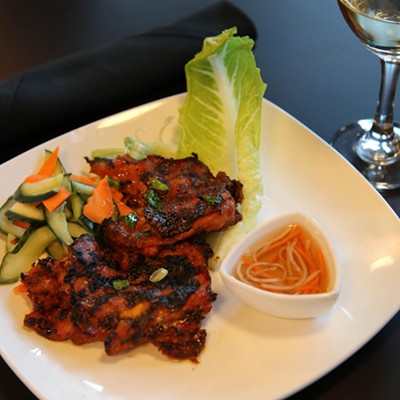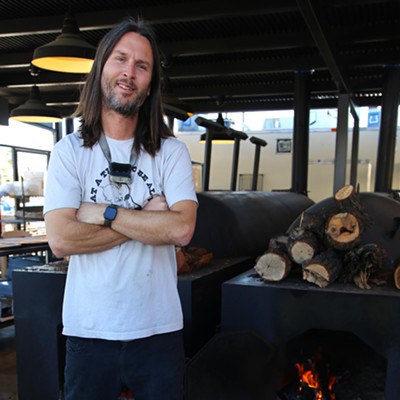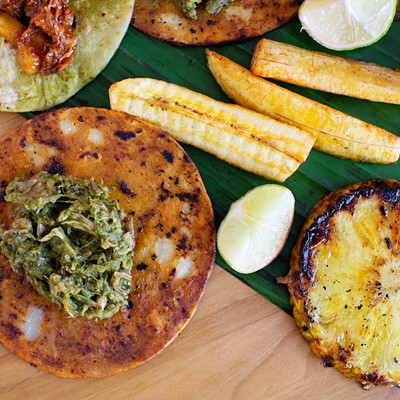For the record, when owner Joseph Abi-Ad answers the phone, he says "el sahzh." A saage--more commonly transliterated as "saaj" or something like it--is essentially an upside-down wok, a domed cooking surface heated by gas (or, more traditionally, wood) used for griddle bread and any number of other things.
Abi-Ad has run Joe's Pancake House on the eastside for more than 20 years, but his most distinctive contribution to Tucson's culinary arts came in the 1990s, when he presided over Le Mediterranean, an elegant Lebanese restaurant on Sabino Canyon Road. The food was flavorful and plentiful; Abi-Ad was a warm host; and you even got live bellydancing a couple of nights a week.
At the beginning of this decade, according to a rumor I heard at the time, Abi-Ad's landlord forced him out of the little strip mall for no good reason, so he retreated to the safety of his pancake batter to plan his next endeavor. And now, here it is.
Compared to Le Mediterranean, El Saage might initially seem like a come-down. Instead of a posh, subtly illuminated, full-service restaurant, El Saage is a brightly lit fast-food joint flanked by La Salsa and Jack in the Box, facing Campbell Avenue in the strip mall on the southwest corner of Campbell and Fort Lowell Road. And the menu has been cut way back--gone are the lamb chops of yore, the savory soups, the fish, the stuffed cabbage.
And yet, Abi-Ad is by no means slumming; he's merely working in a different niche--Middle Eastern fast food--and maintaining a high standard in a more-focused menu.
Let me get my one little complaint out of the way: The day I ordered the meat combo ($12.95), which included beef and chicken shawarma, the shavings of roasted flesh were a bit dry and not as redolent of marinade as I recall from Le Mediterranean. Maybe this was just a fluke of that day's batch, but in any case, the chicken and beef improved with the application of tahini (a sesame paste). The combo also came with kafta, sort of a very well-done (and good-tasting) ground-beef patty, plus rice and a couple of other essentials. The tabouli (cracked wheat and parsley, with an oil and lemon dressing) was very fine, not as bitter as parsley-heavy dishes can be, and the homous (also spelled hummus; it's puréed chickpeas) was creamy and rich. Rice and fluffy wedges of pita bread completed the plate.
The puréed items just may be the standouts at El Saage. The vegetarian combo ($11.95) included baba ghanoush, which was unsurpassed in its incarnation at Le Mediterranean. The day we ordered the veggie combo, the baba was exquisitely smoky; less so, though, a couple of days later, when we ordered it as a separate appetizer. Perhaps it's a question of who's grilling the eggplant before mashing it creamy-smooth with sesame oil, garlic, lemon and salt.
But back to the veggie combo. It also came with the aforementioned homous and pita, but not the "yogurt cucumber" promised on the menu. (I assume this would have been the Lebanese answer to what Indians call raita.) What dominated the plate were two big falafels (deep-fried ground garbanzo balls), which my wife declared to be the best she'd ever tasted (spicy but not oily, they had almost a meaty texture); two stuffed grape leaves, piquant but not the least bit briny; and two spinach-stuffed pastries called fatayer, suffused with but not overpowered by allspice and, maybe, sumac. There was also a little side of garlic sauce, full-bodied but, again, not bitter.
A couple of nights later, we ordered takeout. The falafel plate ($7.95) included six of the title items, every bit as good as before; it came with tahini, more of that great pita, homous, baba ghanoush, rice and a slightly spicy salad-like garnish, by now known quantities. From the appetizer list, we tried the labeni (often transliterated "labneh," $6.95), a mild and smooth strained yogurt cheese, much like cream cheese but not quite as neutral in flavor; it came with a dollop of oil, mint leaves and a couple of olives. From the salads, we ordered fatouch ($4.95), a simple and traditional Lebanese jumble of lettuce (romaine in this case, plus spicy radish) and pita chips in a light dressing of oil, garlic and lemon.
On the subject of oil: Many items (especially those that serve as dips) come with a little pool of it, authentic Lebanese-style. When we use our Lebanese cookbook at home, we drastically reduce the amount of oil, but that healthful effort compromises the flavor. Joe Abi-Ad does not compromise.
El Saage redeemed itself as a purveyor of meat with the lamb-loin kabob plate ($12.95, including pita, tabouli or one of the purées, rice, garnish and garlic sauce or tahini). Here were nice, big cubes of lamb, thoroughly cooked without losing their moisture, savory but not as cloyingly rich as lamb can be.
All these things get re-combined into various other menu options, including sandwiches. About all we didn't try were various appetizers: kibbie (a dish of cracked wheat and raw ground meat for which I never developed a taste), baked chicken wings, lahem bajjin (which I gather is cooked ground beef in phyllo pastry) and manakishe zatar (flat bread topped with an oregano and sesame seed mixture). We also passed up, to my everlasting regret, the baklava. Well, maybe next time. For there will definitely be a next time.









